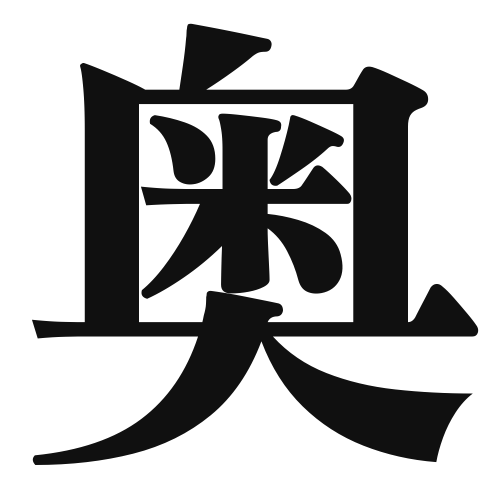1. Overview of Meaning
The kanji “奥” (oku) generally means “inner” or “depth.” It often refers to the inside of something, such as a room or a concept, and can imply a sense of hidden or deeper significance.
2. Formation and Radical
Formation of the Kanji: The kanji “奥” is a combination of the radical “穴” (ana), which means “hole,” and the character “奧” (oku), which represents the idea of depth or inner space. This kanji can be classified as a compound character (会意文字) as it combines elements to convey a more complex meaning.
Radical: The radical of “奥” is “穴” (ana), indicating its connection to concepts of space and enclosure.
3. Examples of Usage
Common Words and Phrases: Some frequently used words that include “奥” are:
- 奥さん (okusan) – wife
- 奥深い (okubukai) – deep, profound
- 奥義 (okugi) – secret teachings or techniques
Example Sentences in Daily Conversation:
- この部屋の奥に何がありますか? (Kono heya no oku ni nani ga arimasu ka?) – What is in the back of this room?
- 彼の考えは奥が深いです。 (Kare no kangae wa oku ga fukai desu.) – His thoughts are profound.
4. Synonyms and Antonyms
Similar Kanji: A similar kanji is “深” (shin), which means “deep.” While both convey a sense of depth, “奥” often implies a hidden or inner aspect, whereas “深” refers more to physical depth.
Opposite Kanji: An antonym for “奥” is “表” (omote), which means “surface” or “front.” This contrasts with the idea of something being hidden or deep within.
5. Cultural and Historical Background
Connection to Japanese Culture: The concept of “奥” is significant in Japanese culture, often associated with the idea of hidden beauty or depth in art, literature, and nature. It reflects the appreciation for subtlety and the unseen.
Proverbs and Idioms: One common saying is “奥が深い” (oku ga fukai), which means “there is more than meets the eye,” emphasizing the idea that deeper understanding is often required to grasp the full meaning of something.
